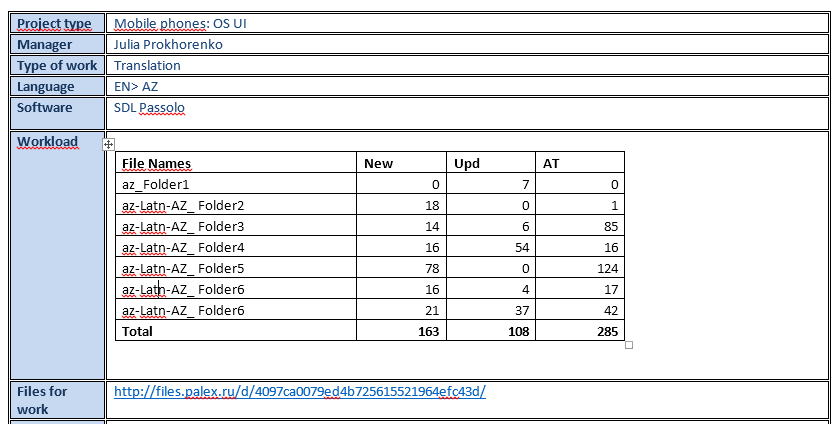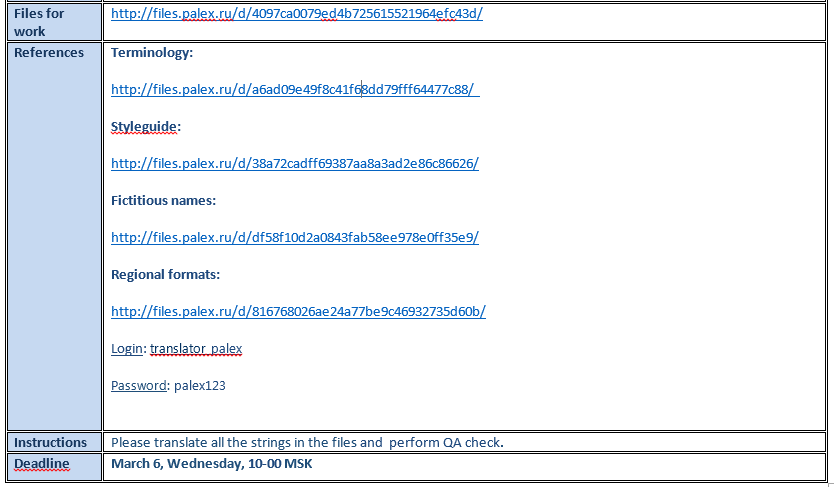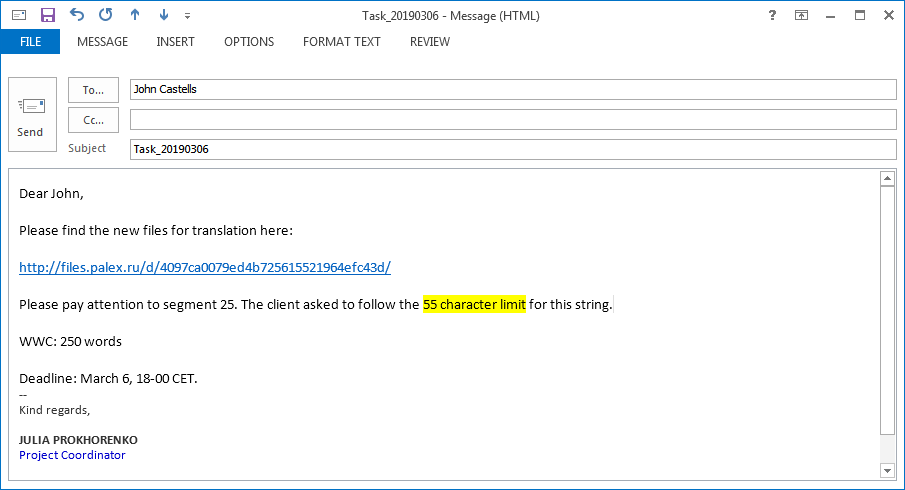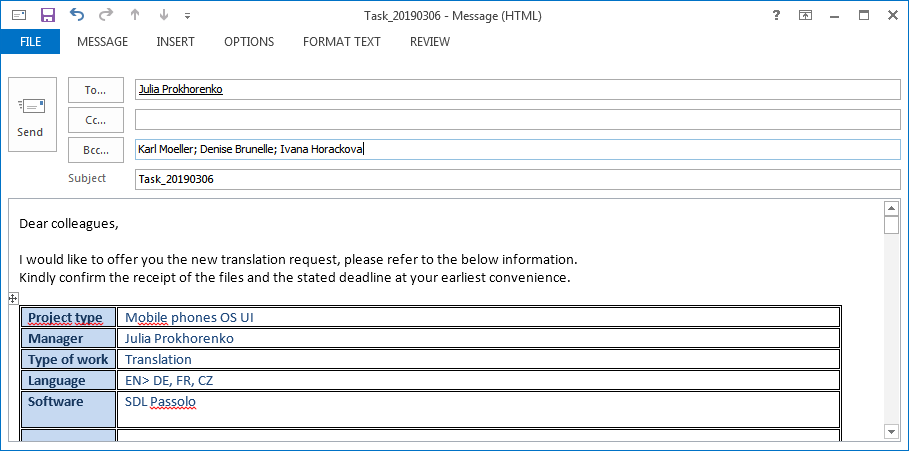 Mail
Mail
 Pocket
Pocket
I work as a project coordinator at a team that is responsible for quick translation. I know what it means to deliver dozens of localization batches every 24 hours. Short turnaround time for me is a daily reality. Let me share this experience with you.
Imagine, you come to the office in the morning, and while your computer is powering up, drink your coffee, thinking of the great day you have ahead. After all, you turned in all of the current projects yesterday and left with a clean slate. When you see your inbox, there are 28 new translation requests. You’re horrified — a part has to be done before lunch! The other part — right after lunch. That may be all right, but you know that you’ll get more urgent requests right after lunch. While you’re thinking about the best way to approach this situation, you get three more requests.
Project managers and coordinators often joke that basically every project deadline is yesterday. Sometimes, when time differences are taken into consideration, this can actually be true. I’ve been a PM for over a year and not once have I received a translation request with a deadline of over 24 hours. Usually, the requests I work with need to be completed in 5−6 hours, if not less. I’m used to this rush life and have worked out an algorithm on how to deal with it, even if the client is waiting for the translation one hour after sending the request. I actually am somewhat shocked when my colleagues get requests for 100 words with a three-day turnaround. A short turnaround time is not a death sentence for your success, you just need to be well prepared and act right away. Remember — never procrastinate!
| Deadline | Volume | What to do? |
|---|---|---|
| Today, in an hour | 20 words | The first to begin and deliver. |
| Tomorrow morning | 200 words | Can be the last to begin. |
| Tomorrow at lunch | 2000 words | Start right after the first one — there’s not that much time for completion. |
| Today, in the evening | 500 words | Start right after the most urgent requests are sent out to the translators. |
| Today, in two hours | 10 words | Send to the translator with the first urgent request. |
Every minute counts on projects with a short turnaround time, so be sure to save time where possible.
Don’t waste your time writing to those translators who you know will refuse the job or won’t reply at all. Remember who works during the morning and day, and who prefers to accept work only in the evenings and at night. I also try to follow what jobs contractors are currently working on. This goes for my projects, as well as the projects of my colleagues. If a translator received a job for 10 000 words yesterday with a turnaround time of 5 days, don’t try and convince them to take another 5000 — you’re likely to waste the time you don’t have.
Outlook email templates help me send out handoffs very quickly. It’s better to spend some time on creating a template once and save up to 30 minutes a day on writing separate emails to everyone later.
A good template of an email to a linguist includes:
If your email doesn’t include these, you’re doomed to spend a lot of time on explanations and likely won’t complete the job on time.
I have a template that covers most of the projects I work on. I try to fit all of the necessary information into it, considering the questions that linguists most often ask me. My main goal is to avoid any additional questions.

The first part of the template includes information on the specific job: the type of project, type of work, language pair and software to be used. I also include the number of words and where to get the files for translation.

The second part of the template includes all of the necessary references: links to the glossary, instructions, style guides and information to log into the portals where these are located. I also include any order in which the files should be worked on and the deadline.
For those linguists who often work on the same type of a project and know the references better than me, I can omit a part of the instructions and just send the files and deadline.

A task for an “experienced” linguist: only the information about the files to work on, the deadline and small specifics for this task. It takes about a minute to write this email
I usually work on projects that include translation files prepared by the client. But sometimes there are projects that will require you to create a package of documents to be translated in a CAT tool. This is when you have to manually add files and glossaries, and set up checks for each linguist. Many CAT tools allow you to create a template that can be used to create packages with necessary references for several languages at a time in just a couple of clicks. You can read about how to do this in SDL Trados Studio and start multi-language projects seven times faster.
You already have the handoff and CAT tool templates but you can save even more time by sending a mass email. Instead of sending dozens of individual emails, I use the BCC option: enter my own email in the “To” field and the emails of several contractors in the “BCC” field.

The header of the handoff email with a task in#nbsp;several language pairs: all of the email addresses are in the BCC.
When all of the tasks are sent out, go back to your priority list and prepare the next handoff and mass email. Don’t forget to re-prioritize — if you received new urgent jobs while you were dealing with the current ones, you need to see what should be moved to the top of the list.
All of the PMs are taught that they should never send out work with delivery right at the time the job is due to the client — there should always be an “airbag” of time just in case. On projects with short turnaround time, this can be 5−6 minutes, but even this could be enough to take care of mistakes.
When I receive the translation, I check it myself using the resources that come with my CAT tools. Of course, this is not the perfect approach to QA, but it can catch obvious mistakes and fix them: additional spaces, missing placeholders, or segments that weren’t translated. Ask the translator to be available right after the job is delivered, in case you find mistakes that need to be corrected.
Ideally, you’re looking to get a perfect translation from the initial linguist, especially if you pushed for time. But in practice it doesn’t work like that. Even the best linguist can misspell or skip important instructions. And translation of “mediocre” freelancers needs to be carefully checked.
Give out jobs in such a way that there’s time to edit after receiving the translation. For example, give out short and urgent work to trusted translators— editing their texts will not take much time. But send those tasks that have a longer turnaround time to the mediocre guy and schedule enough time for a thorough check.
It’s unlikely that you’ll have the time to complete the LQA step before turning in the project to the client. However, this doesn’t mean that you shouldn’t do it at all. What you should do is come up with a schedule of regular LQA checks for all of your translators. For example, I complete LQA of all the people I work with once a month.
Of course, if mistakes are found, you won’t be able to do anything about them, since you’ve long delivered the job to the client. But the results will help you understand who can be trained and who should try to translate another projects. If you know the weak points of the people you work with, you will be able to plan ahead. Those that are known to put too many spaces or forget the period at the end of the sentence, can be checked by a QA tool. But those who make mistake in terminology or constantly mistranslate will need to be checked by an experienced editor. Don’t forget to send the LQA results to the contractor — it’s possible that this will be enough for them to show a better result the next time around.
I have a checklist that helps me remember how to act quickly and not overlook any details.






